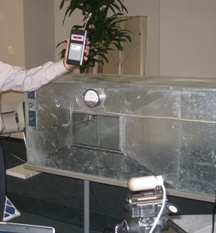
A great deal of effort has been expended analyzing filter test results and procedures. Are these results consistent with indoor particle counts?
The ASHRAE 52.2 filter tests are designed to provide a measure of the efficiency of filters by particle size. While the MERV numbers determined by the tests give an indication of how a filter will perform on particles that reach a filter, this does not mean that these numbers will reflect particle removal efficiency in an indoor space.
Particles in an indoor space come from outdoor to indoor transfer, indoor sources and indoor air chemistry. They are removed by deposition (gravity), breathing of the individuals in the space, ventilation and particle removal devices such as a filter in an HVAC system or another air cleaning device. The efficiency of the particle removal of the filter is dependent on the efficiency of the filter, the size and aerodynamic characteristics of the particles in the space, the air changes per hour (ACH) of the HVAC system, the run time of the HVAC system and the air distribution of the HVAC system. And here is the problem, in most cases the particles in the space never reach the filter. In other cases, the particle generation factors far outweigh the ability of the removal mechanisms to reduce indoor particle concentrations. The result is that the indoor particle counts by particle size do not reflect the particle reductions found in the filter test results. They are not even close.
The prime example is what happens with particles in the 3 to 10 micrometer size range (E3) in an indoor space with alot of activity such as a school (or casino). The generation of particles by human activity overwhelms the air cleaning. This is especially true when you consider the difficulty of moving these particles to the filtration system. Their larger size means that they move slowly and often fall out of the air before they reach the filter. In fact, in most cases the majority of particles in the E3 range never reach the filter. So when you take particle counts in a space instead of having the 70% or 95% reduction we would expect based on the efficiency of the filter, we have very little reduction or at best 30-40% reduction in indoor particle counts in the 5 or 10 micrometer range.
For example, we conducted a test in a room 16 feet by 22 feet with 8 foot ceilings using a dedicated test duct. This duct was set to 2,000 cfm and contained a MERV 14 filter. The duct provided approximately 40 ACH for the room. A MERV 14 filter must have a composite minimum test result in the ASHRAE 52.2 test of between 75% and 85% efficiency in particles 0.3 to 1 micrometer, a greater than 90% efficiency on particles in the 1 to 3 micrometer size range and a 90% plus efficiency on particles between 3 and 10 micrometers.
The starting baseline in the room before turning on the test duct showed particle counts of 3,564,000 in the 0.3 um range, 239,000 in the 0.5 um range, 14,170 in the 1.0 um range, 2,940 in the 2.5 um range, 880 in the 5 um range and 560 in the 10 um range. There was activity in the room with 18 people and the door was open to the rest of the office facility. After 30 minutes of operation of the test duct which gave 20 air changes in the room, the following particle counts were recorded. There were 1,800,000 particles in the 0.3 um range, 127,350 in the 0.5 um range, 8,070 in the 1 um range, 2,480 in the 2.5 um range, 860 in the 5 um range, and 530 in the 10 um range. This gave us a reduction of 49.5% in the 0.3 um range, 46.7% in the 0.5 um range, 43% in the 1 um range, 15.6% in the 2.5 um range, 2.3% in the 5 um range and 5.4% in the 10 um range. This test has been repeated several times with essentially the same results. The reductions in the particle counts in the room do not correlate with the filter particle efficiencies in the tests.
| Size | Start Count | Predicted | Actual |
| 0.3um | 3,564,000 | 1,211,760 | 1,800,000 |
| 0.5um | 239,000 | 64,530 | 127,350 |
| 1um | 14,170 | 2,125 | 8,070 |
| 2.5um | 2,940 | 180 | 2,480 |
| 5um | 880 | 20 | 860 |
| 10um | 560 | 5 | 530 |
Therefore, it is important to understand that an air filter is only one component in an indoor air system. For a filter to be effective, there must be a combination of three factors – Filter + Fit + Flow. Source control, differential pressure and air distribution are also important. But, if particles do not reach a filter, they cannot be removed by that filter. Claims of filter efficiency need to be viewed in this perspective.